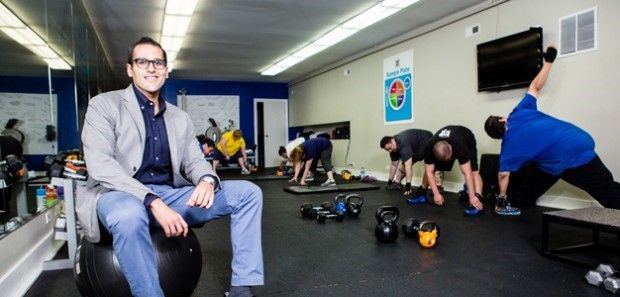Downsize Fitness Only Lets Overweight People Join: New Members Must Have 50 Lbs. To Lose And BMI Over 30

Downsize Fitness isn’t your average gym. Deadlift plates don’t clang as they smash down on the floor. Sinewy millenials don’t inspect their abs in the mirror. Bodybuilders — there are none.
Opened in 2011 by founder Francis Wisniewski, the Chicago-based gym caters to the obese. Not just the marginally overweight — the mom returning after a pregnancy and the dad carrying some sympathy weight — but rather, the people who need transformations. They didn’t simply miss an exit somewhere; they’re speeding in the wrong direction. Downsize Fitness members need help relearning how to live healthy, and the gym’s owners say the best way to get there is through community.
“Anyone who goes through a transformation like that,” says Downsize CEO Kishan Shah, “it is so vast that it changes your entire outlook and makes you want to help others.”
Shah was heavy once — 400 lbs. to be exact. He’s since cut that number in half and has spent the last nine-and-a-half years devoting his life to fitness and personal health. He has visited 100 different gyms in 30 countries strictly to enrich Downsize’s vision — only after he had lost the weight, he says; before, it was impossible to ride a plane without buying two seats.
Since November of 2011, the gym’s members have lost a total of 5,500 lbs., Shah says. “They’re literally living before and after pictures.” One man used to receive insulin injections before losing 100 lbs. Now he runs marathons. Similar success stories abound.
But the stories are anything if record-breaking. Shah emphasizes that new members aren’t joining in the hopes of climbing mountains or competing in the Ironman. Sure, they may get there eventually, but first they’re focusing on fitting into roller coaster seats, or walking a block without getting winded. The ultra-tough gymnastic-weightlifting hybrid, CrossFit, is based on functional movement performed at high intensity. Downsize Fitness says, “Let’s just focus on the movement part for now.”
“What we do at Downsize is focus on functional fitness – broadly defined as anything that helps you live and meet a healthy life,” Shah told the Daily Beast. “The primary consideration people have when joining is not because they’re interested in looking better. It’s generally that they want to be able to get up off the floor, or keep up with their kids, or live to see their grandchildren.”
And the stories don’t have to end with the weight loss, he says. While new members must fit a certain profile to join the gym — having an extra 50 lbs. to lose is mostly for branding purposes, he says; they use body fat and body mass index (BMI) as well — members who accomplish their weight loss goals, putting themselves out of eligibility, aren’t required to find a new gym. Often, they don’t want to. It’s part of the gym’s ongoing mission to build community.
“The members serve to mentor each other,” Shah notes, adding that many of the success stories even go on to become staffed trainers at Downsize. “You’re creating more than a fitness class. You’re creating a community.”
The services offered at Downsize — dieticians and nutritionists are on staff alongside trained mental health personnel — reflect a departure from traditional gyms. Part of Shah’s enduring mission is to create a safe space at Downsize, one where people don’t have to feel embarrassed about not being able to find clothes that fit or discussing the shame of a food addiction. The gym’s windows are even frosted for added privacy. It’s a space that affirms obesity as a disease, in the same way alcoholism support groups thrive on communication and trust.
“It’s funny how taboo a subject this is,” Shah says. “Simply providing a safe space for someone to speak about what they’re feeling, regardless of how trivial it may seem, is so important.”
In the United States alone, more than a third of all adults are obese (35.7 percent), according to the Centers for Disease Control and Prevention. The annual medical cost for such a staggering percentage, which increases the risk for heart disease, stroke, type 2 diabetes, and some cancers with each uptick, hovers around $150 billion. Per capita, the medical costs for obese people were $1,429 higher in 2008 than people of healthy weight.
This, above all else, is Shah’s primary motivation in curbing unhealthy lifestyles. It’s about more than a number on a scale, he says. It’s about “how you look in the mirror, how happy you are, how well your clothes fit, how you feel when you wake up, how you feel about yourself.”
“I would never want someone to come into Downsize and say, I lost 60 lbs. in one week,” he stresses. “That’s just unhealthy. Weight loss is important, but what’s really important is making them healthier and happier.”



























